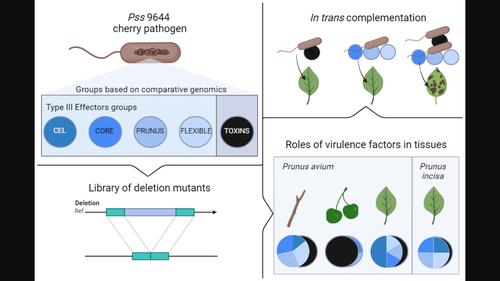当前位置:
X-MOL 学术
›
Mol. Plant Pathol.
›
论文详情
Our official English website, www.x-mol.net, welcomes your feedback! (Note: you will need to create a separate account there.)
Genetic dissection of the tissue‐specific roles of type III effectors and phytotoxins in the pathogenicity of Pseudomonas syringae pv. syringae to cherry
Molecular Plant Pathology ( IF 4.9 ) Pub Date : 2024-04-09 , DOI: 10.1111/mpp.13451 Andrea Vadillo‐Dieguez 1, 2 , Ziyue Zeng 1 , John W. Mansfield 3 , Nastasiya F. Grinberg 1 , Samantha C. Lynn 1 , Adam Gregg 1 , John Connell 1 , Richard J. Harrison 1, 2, 4 , Robert W. Jackson 2 , Michelle T. Hulin 1, 5
Molecular Plant Pathology ( IF 4.9 ) Pub Date : 2024-04-09 , DOI: 10.1111/mpp.13451 Andrea Vadillo‐Dieguez 1, 2 , Ziyue Zeng 1 , John W. Mansfield 3 , Nastasiya F. Grinberg 1 , Samantha C. Lynn 1 , Adam Gregg 1 , John Connell 1 , Richard J. Harrison 1, 2, 4 , Robert W. Jackson 2 , Michelle T. Hulin 1, 5
Affiliation

|
When compared with other phylogroups (PGs) of the Pseudomonas syringae species complex, P. syringae pv. syringae (Pss) strains within PG2 have a reduced repertoire of type III effectors (T3Es) but produce several phytotoxins. Effectors within the cherry pathogen Pss 9644 were grouped based on their frequency in strains from Prunus as the conserved effector locus (CEL) common to most P. syringae pathogens; a core of effectors common to PG2; a set of PRUNUS effectors common to cherry pathogens; and a FLEXIBLE set of T3Es. Pss 9644 also contains gene clusters for biosynthesis of toxins syringomycin, syringopeptin and syringolin A. After confirmation of virulence gene expression, mutants with a sequential series of T3E and toxin deletions were pathogenicity tested on wood, leaves and fruits of sweet cherry (Prunus avium ) and leaves of ornamental cherry (Prunus incisa ). The toxins had a key role in disease development in fruits but were less important in leaves and wood. An effectorless mutant retained some pathogenicity to fruit but not wood or leaves. Striking redundancy was observed amongst effector groups. The CEL effectors have important roles during the early stages of leaf infection and possibly acted synergistically with toxins in all tissues. Deletion of separate groups of T3Es had more effect in P. incisa than in P. avium . Mixed inocula were used to complement the toxin mutations in trans and indicated that strain mixtures may be important in the field. Our results highlight the niche‐specific role of toxins in P. avium tissues and the complexity of effector redundancy in the pathogen Pss 9644.
中文翻译:

III 型效应子和植物毒素在丁香假单胞菌致病性中的组织特异性作用的基因剖析。丁香花到樱桃
与其他系统群(PG)相比丁香假单胞菌 物种复杂,丁香假单胞菌 光伏。 s丁香科 PG2 内的 (Pss) 菌株具有减少的 III 型效应子 (T3E) 库,但会产生多种植物毒素。樱桃病原体 Pss 9644 内的效应子根据其在菌株中的频率进行分组李属 作为大多数人常见的保守效应基因座 (CEL)丁香假单胞菌 病原体; PG2 共有的效应器核心;一组樱桃病原体常见的 PRUNUS 效应子;以及一组灵活的 T3E。 Pss 9644 还含有用于生物合成丁香霉素、丁香肽和丁香素 A 毒素的基因簇。在确认毒力基因表达后,对具有一系列连续 T3E 和毒素缺失的突变体进行了对甜樱桃木材、叶子和果实的致病性测试。樱桃 )和观赏樱桃叶(切叶李 )。这些毒素在水果疾病的发展中起着关键作用,但在叶子和木材中的重要性较低。无效应突变体保留了对果实的一些致病性,但不保留木材或叶子。在效应组中观察到了惊人的冗余。 CEL 效应子在叶片感染的早期阶段发挥着重要作用,并且可能与所有组织中的毒素协同作用。删除单独的 T3E 组具有更大的效果切齿杨 比在鸟青霉 。混合接种物用于补充反式毒素突变,表明菌株混合物在该领域可能很重要。我们的结果强调了毒素的利基特异性作用鸟青霉 组织和病原体 Pss 9644 中效应器冗余的复杂性。
更新日期:2024-04-09
中文翻译:

III 型效应子和植物毒素在丁香假单胞菌致病性中的组织特异性作用的基因剖析。丁香花到樱桃
与其他系统群(PG)相比



























 京公网安备 11010802027423号
京公网安备 11010802027423号